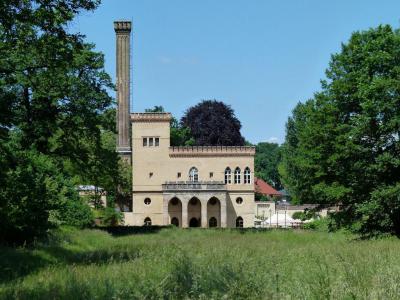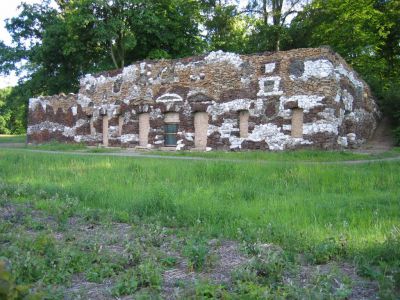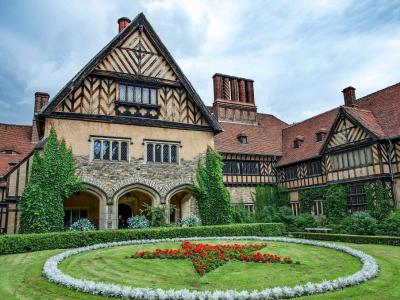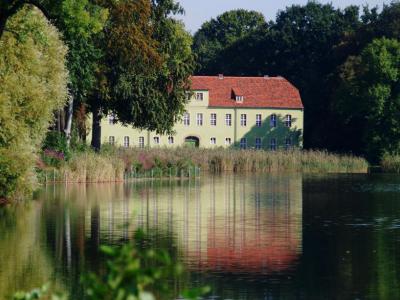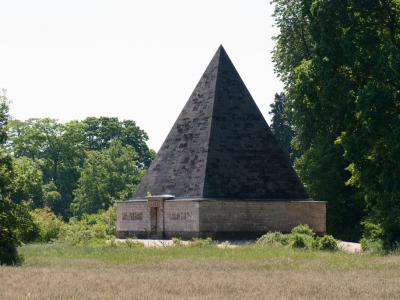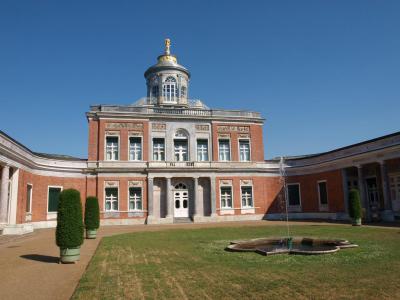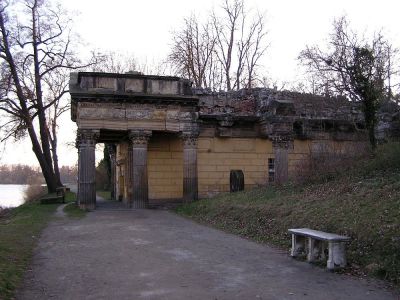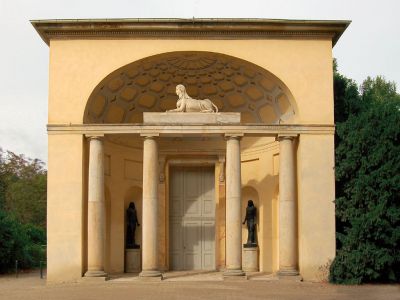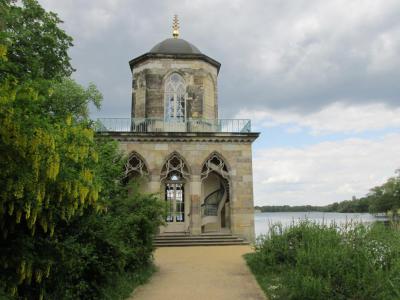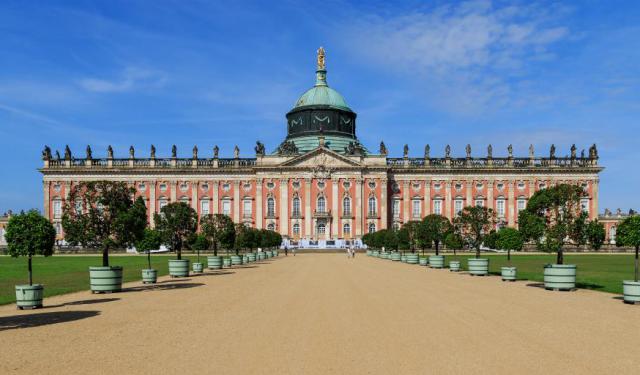
Neuer Garten Walking Tour (Self Guided), Potsdam
Laid out at the behest of Friedrich William II in 1787, Potsdam's Neuer Garten (New Garden) was indeed "new" compared to the already in place Sanssouci Park.
Between 1816 and 1828, the area was modified further as an English-style, open landscape garden, with an aim to reproduce nature – trees and plants were left to grow naturally, unshaped and untrimmed. Rural life was also "rediscovered" in the form of browsing cows made part of the scene; their milk was processed to butter and cheese right on the site, at the northwest corner of the park, in the Meierei (Dairy). The latter is still in place and today houses a lakeshore restaurant.
A short walk down the path along the Jungfernsee lake leads to the Muschelgrotte (Shell Grotto). Currently restored, this location, along with other pieces of the garden architecture, back in the day served the king as a place of mystical purification. Interestingly enough, at the time of the Berlin Wall, the entire lake shore area here was sealed off by wire fence.
Not far off is the Cecilienhof Castle, the last palace of the Hohenzollern dynasty, erected between 1913 and 1917. The imperial crown prince lived here with his family until 1945 – that same year, the Potsdam Conference took place in the palace.
Further afield is the Green House, one of the summer houses designated by their color, alongside the Brown, the Red, and suchlike houses survived to this day.
When the park trees thin out, in autumn, the Marmorpalais (Marble Palace) comes into view. This summer residence of Frederick II's successor, Friedrich Wilhelm, in East Germany times served as an army museum.
Overall, the sprawling Neuer Garten in Potsdam covers 102 hectares of land and is dotted with a plethora of architectural gems. If you wish to admire them up close, follow this self-guided walk.
Between 1816 and 1828, the area was modified further as an English-style, open landscape garden, with an aim to reproduce nature – trees and plants were left to grow naturally, unshaped and untrimmed. Rural life was also "rediscovered" in the form of browsing cows made part of the scene; their milk was processed to butter and cheese right on the site, at the northwest corner of the park, in the Meierei (Dairy). The latter is still in place and today houses a lakeshore restaurant.
A short walk down the path along the Jungfernsee lake leads to the Muschelgrotte (Shell Grotto). Currently restored, this location, along with other pieces of the garden architecture, back in the day served the king as a place of mystical purification. Interestingly enough, at the time of the Berlin Wall, the entire lake shore area here was sealed off by wire fence.
Not far off is the Cecilienhof Castle, the last palace of the Hohenzollern dynasty, erected between 1913 and 1917. The imperial crown prince lived here with his family until 1945 – that same year, the Potsdam Conference took place in the palace.
Further afield is the Green House, one of the summer houses designated by their color, alongside the Brown, the Red, and suchlike houses survived to this day.
When the park trees thin out, in autumn, the Marmorpalais (Marble Palace) comes into view. This summer residence of Frederick II's successor, Friedrich Wilhelm, in East Germany times served as an army museum.
Overall, the sprawling Neuer Garten in Potsdam covers 102 hectares of land and is dotted with a plethora of architectural gems. If you wish to admire them up close, follow this self-guided walk.
How it works: Download the app "GPSmyCity: Walks in 1K+ Cities" from Apple App Store or Google Play Store to your mobile phone or tablet. The app turns your mobile device into a personal tour guide and its built-in GPS navigation functions guide you from one tour stop to next. The app works offline, so no data plan is needed when traveling abroad.
Neuer Garten Walking Tour Map
Guide Name: Neuer Garten Walking Tour
Guide Location: Germany » Potsdam (See other walking tours in Potsdam)
Guide Type: Self-guided Walking Tour (Sightseeing)
# of Attractions: 9
Tour Duration: 2 Hour(s)
Travel Distance: 2.8 Km or 1.7 Miles
Author: nataly
Sight(s) Featured in This Guide:
Guide Location: Germany » Potsdam (See other walking tours in Potsdam)
Guide Type: Self-guided Walking Tour (Sightseeing)
# of Attractions: 9
Tour Duration: 2 Hour(s)
Travel Distance: 2.8 Km or 1.7 Miles
Author: nataly
Sight(s) Featured in This Guide:
- Meierei (The Dairy)
- Muschelgrotte (Shell Grotto)
- Cecilienhof Palace
- Green House
- Pyramide (Ice House)
- Marmorpalais (Marble Palace)
- Schlosskueche (Palace Kitchen)
- Orangery in New Garden
- Gothische Bibliothek (Gothic Library)
1) Meierei (The Dairy)
Meierei, the Dairy, was built to supply the royal court of Frederick William II of Prussia. Cows grazed on the land near the Marble Palace and landscape garden with the Meierei manufacturing butter and cheeses. It was built in 1792 by Andreas Ludwig Kruger using plans from Carl Gotthard Langhans.
A second story was added to the building in the mid-19th century. Frederick William IV hired architect Ludwig Persius and building Ludwig Ferdinand Hesse to add a tower, battlements and a pump house to the existing structure.
Meierei was no longer used as a dairy by the beginning of the 20th century. It was transformed into a popular restaurant in 1928. After World War II, the building fell into disrepair and remained unused until 1991. It was re-opened in 2003 as a restaurant and brewery, almost 200 years after its construction.
Visitors can go to Meierei for a meal or a drink during its open hours from noon to 8 PM Wednesday, Thursday and Sunday or noon to 10 PM on Friday and Saturday. The brewery serves non-alcoholic drinks like sodas, wine, coffee, teas and juices. It also serves a variety of beers, wines and mixed drinks.
A second story was added to the building in the mid-19th century. Frederick William IV hired architect Ludwig Persius and building Ludwig Ferdinand Hesse to add a tower, battlements and a pump house to the existing structure.
Meierei was no longer used as a dairy by the beginning of the 20th century. It was transformed into a popular restaurant in 1928. After World War II, the building fell into disrepair and remained unused until 1991. It was re-opened in 2003 as a restaurant and brewery, almost 200 years after its construction.
Visitors can go to Meierei for a meal or a drink during its open hours from noon to 8 PM Wednesday, Thursday and Sunday or noon to 10 PM on Friday and Saturday. The brewery serves non-alcoholic drinks like sodas, wine, coffee, teas and juices. It also serves a variety of beers, wines and mixed drinks.
2) Muschelgrotte (Shell Grotto)
The Muschelgrotte, known as the Shell Grotto in English, is a grotto located in the New Garden. It was commissioned by Friedrich Wilhelm II and built by Friedrich Ludwig Carl Kruger in 1794. It was modeled after the grotto in the palace gardens of Oranienburg.
Kruger designed the grotto to appear as though it was naturally occurring rather than manmade. To achieve this, the building was covered with bog iron stone, calcareous tuff, gypsum stone and slag from the surrounding region. The interior of the grotto was covered in glasses of various colors, shells and snails. The open, domed ceiling was designed by artist Bartolomeo Verona with birds and reeds flocked around the edges.
The purpose of the Muschelgrotte was for tea parties and dining. However, it was rarely used and fell into complete disrepair by the mid-20th century. Today, visitors can explore the Muschelgrotte where they will see the beauty behind the ruins of this structure.
Kruger designed the grotto to appear as though it was naturally occurring rather than manmade. To achieve this, the building was covered with bog iron stone, calcareous tuff, gypsum stone and slag from the surrounding region. The interior of the grotto was covered in glasses of various colors, shells and snails. The open, domed ceiling was designed by artist Bartolomeo Verona with birds and reeds flocked around the edges.
The purpose of the Muschelgrotte was for tea parties and dining. However, it was rarely used and fell into complete disrepair by the mid-20th century. Today, visitors can explore the Muschelgrotte where they will see the beauty behind the ruins of this structure.
3) Cecilienhof Palace (must see)
Schloss Cecilienhof (Cecilienhof Palace) is a palace in the northern part of the Neuer Garten park in Potsdam, close to the Jungfernsee lake. It has been part of the Palaces and Parks of Potsdam and Berlin UNESCO World Heritage Site since 1990.
Cecilienhof was the last palace built by the Hohenzollern family. Emperor Wilhelm II of Germany had it erected for his son, Crown Prince Wilhelm of Germany, and the crown prince's wife Duchess Cecilie of Mecklenburg-Schwerin. The house was designed by Paul Schultze-Naumburg to look like an English Tudor country house and built between 1914 and 1917. Its design was based on a house called 'Bidston Court' (later 'Hillbark') on the Wirral Peninsula, which in turn was inspired by Little Moreton Hall. The interior was furnished according to plans by Paul Troost, who originally had designed steamship décors.
Cecilienhof was the location of the Potsdam Conference between 17 July and 2 August 1945. The rooms had been largely refurnished to match the taste of the participants. Winston Churchill, later Clement Attlee, Joseph Stalin and Harry S. Truman met at the round table in the great hall. On 26 July 1945 Churchill and Truman issued the Potsdam Declaration defining the terms for Japanese surrender, while Truman had already given order to prepare the atomic bombing of Hiroshima and Nagasaki.
Today Cecilienhof is a museum as well as a hotel. Queen Elizabeth II visited Cecilienhof on 3 November 2004. On 30 May 2007, the palace was used for the G8 foreign ministers summit.
Cecilienhof was the last palace built by the Hohenzollern family. Emperor Wilhelm II of Germany had it erected for his son, Crown Prince Wilhelm of Germany, and the crown prince's wife Duchess Cecilie of Mecklenburg-Schwerin. The house was designed by Paul Schultze-Naumburg to look like an English Tudor country house and built between 1914 and 1917. Its design was based on a house called 'Bidston Court' (later 'Hillbark') on the Wirral Peninsula, which in turn was inspired by Little Moreton Hall. The interior was furnished according to plans by Paul Troost, who originally had designed steamship décors.
Cecilienhof was the location of the Potsdam Conference between 17 July and 2 August 1945. The rooms had been largely refurnished to match the taste of the participants. Winston Churchill, later Clement Attlee, Joseph Stalin and Harry S. Truman met at the round table in the great hall. On 26 July 1945 Churchill and Truman issued the Potsdam Declaration defining the terms for Japanese surrender, while Truman had already given order to prepare the atomic bombing of Hiroshima and Nagasaki.
Today Cecilienhof is a museum as well as a hotel. Queen Elizabeth II visited Cecilienhof on 3 November 2004. On 30 May 2007, the palace was used for the G8 foreign ministers summit.
Sight description based on Wikipedia.
4) Green House
The Green House is a summer house in the New Garden. It was built as part of a trio along with the Brown and Red Houses. The Green House was part of Frederick William II's plan to create a park with an English landscape structure that would stand in contrast to Frederick the Great's Sanssouci.
The English landscape design was known for its architecture rather than natural elements like trees and water features. Any landscaping was meant to be allowed to grow wildly without delicate trimming. The Green House is one of the buildings that was designed to enhance the English-garden style. It is one of the few that still stands as it did when it was first built.
Other buildings that were designed at the same time as the Green House include the Marble Palace, the Palace Kitchen, the Orangery, the Gothic Library, the Pyramide, the Dairy, the Grotto and the Hermitage Pavilion.
The English landscape design was known for its architecture rather than natural elements like trees and water features. Any landscaping was meant to be allowed to grow wildly without delicate trimming. The Green House is one of the buildings that was designed to enhance the English-garden style. It is one of the few that still stands as it did when it was first built.
Other buildings that were designed at the same time as the Green House include the Marble Palace, the Palace Kitchen, the Orangery, the Gothic Library, the Pyramide, the Dairy, the Grotto and the Hermitage Pavilion.
5) Pyramide (Ice House)
The Pyramide is a masonic building located near the Marble Palace in the New Garden. It was designed by architects Carl Gotthard Langhans and Andreas Ludwig Kruger, who were freemasons. Its construction was ordered by Friedrich Wilhelm II. It was completed in 1792.
The building was used as an ice house. Frozen lake ice was stored in the floor of the Pyramide's cellar where perishable food was kept cool throughout the year. The cellar of the Pyramide is about five meters (16 feet) underground.
Visitors may not enter the Pyramide due to its poor condition. However, it is still a lovely sight that is an important part of any Potsdam tour. Along with the unique design, the exterior of the Pyramide displays Egyptian hieroglyphics and astrological signs.
Egyptian-inspired decor and architecture is found throughout the New Garden. Some of these items include a variety of obelisks, two Antinous statues and a sphinx. The Pyramide was the first Egyptian-inspired building on the grounds.
The building was used as an ice house. Frozen lake ice was stored in the floor of the Pyramide's cellar where perishable food was kept cool throughout the year. The cellar of the Pyramide is about five meters (16 feet) underground.
Visitors may not enter the Pyramide due to its poor condition. However, it is still a lovely sight that is an important part of any Potsdam tour. Along with the unique design, the exterior of the Pyramide displays Egyptian hieroglyphics and astrological signs.
Egyptian-inspired decor and architecture is found throughout the New Garden. Some of these items include a variety of obelisks, two Antinous statues and a sphinx. The Pyramide was the first Egyptian-inspired building on the grounds.
6) Marmorpalais (Marble Palace)
The Marmorpalais, known in English as the Marble Palace, was a royal residence built on the shore of Lake Heiliger in the New Garden. The Marble Palace was commissioned by King Friedrich Wilhelm II for use as a summer home by the Hohenzollern family. It was designed in the Neoclassical architectural style by Carl von Gontard and Carl Gotthard Langhans. Construction of the Marble Palace was completed in 1791.
The palace was originally a square, two-story building with a round pavilion on the roof. A stairway and gallery was also constructed on the roof to lead to the belvedere. A large terrace on the lake side had a stairway that led to the water where boat moorings were easily reached. The lake shore was also home to the palace kitchen, which was designed to resemble a romantic, classical temple ruin.
The Marble Palace was expanded with two side wings in 1797. These wings were designed by Michael Philipp Boumann using marble from the colonnades of Park Sanssouci.
The palace was significantly damaged during World War II. It was no longer used as a palace at that point and continued to fall into ruin. A restoration project began in 1988. It was not completed until 2009. The Marble Palace was named a UNESCO World Heritage Site in 1990.
The Marble Palace is only open on Saturdays and Sundays from November through April. During the summer season, the palace is open from Tuesday through Sunday from 10 AM to 5:30 PM. Visitors can explore on their own or wait for guided tours that take place every 30 minutes.
The palace was originally a square, two-story building with a round pavilion on the roof. A stairway and gallery was also constructed on the roof to lead to the belvedere. A large terrace on the lake side had a stairway that led to the water where boat moorings were easily reached. The lake shore was also home to the palace kitchen, which was designed to resemble a romantic, classical temple ruin.
The Marble Palace was expanded with two side wings in 1797. These wings were designed by Michael Philipp Boumann using marble from the colonnades of Park Sanssouci.
The palace was significantly damaged during World War II. It was no longer used as a palace at that point and continued to fall into ruin. A restoration project began in 1988. It was not completed until 2009. The Marble Palace was named a UNESCO World Heritage Site in 1990.
The Marble Palace is only open on Saturdays and Sundays from November through April. During the summer season, the palace is open from Tuesday through Sunday from 10 AM to 5:30 PM. Visitors can explore on their own or wait for guided tours that take place every 30 minutes.
7) Schlosskueche (Palace Kitchen)
The Schlosskueche, or Palace Kitchen, was added to the Sanssouci Palace after King Friedrich Wilhelm IV ascended to the throne in 1840. He and his wife, Elizabeth of Bavaria, spent summers at Sanssouci. The east wing of the palace was turned into a kitchen, bakery and a coffee maker's room. It also held the silver collection, which is now the location of the museum shop, and the pantry.
The Palace Kitchen used what was then a modern appliance known as the cooking machine. It allowed the staff, whose quarters were above the Palace Kitchen, to use heated portions of the machine rather than an open flame.
Visitors may now tour the Palace Kitchen where they will find the cooking machine alongside copper and porcelain dishes and baking trays. The Palace Kitchen is closed from November to March but stays open from 10 AM through 5:30 PM Tuesday through Sunday during the summer season.
The Palace Kitchen used what was then a modern appliance known as the cooking machine. It allowed the staff, whose quarters were above the Palace Kitchen, to use heated portions of the machine rather than an open flame.
Visitors may now tour the Palace Kitchen where they will find the cooking machine alongside copper and porcelain dishes and baking trays. The Palace Kitchen is closed from November to March but stays open from 10 AM through 5:30 PM Tuesday through Sunday during the summer season.
8) Orangery in New Garden
250 meters from the Marble Palace, in the southern part of Neuer Garten, stands the Orangery. This 86-meter long structure was built on order by Prussian King Friedrich Wilhelm II, between 1791 and 1793. Designed by Carl Gotthard Langhanns, the Orangery was meant for overwintering valuable exotic plants – the capacity in which it still serves today.
Apparently, the architect took inspiration from Egyptian mythology – the entrance to the building resembles an Egyptian portal. On the east side of it, above the door, lies a guarding sphinx. Additionally, two black statues of Egyptian gods, placed inside the wall niches, adorn another semicircular entrance area. All these sculptures were created by Johann Gottfried Schadow.
Two halls, to the east and the west, are for plants. The one in the middle, called the Palm Hall (for its decor of palm trees), is exquisitely furnished with yew, plum and elm wood panels. Large windows and a central door on the south side open to a marvelous view of the perennial garden situated in front of the Orangery.
Apart from sheltering exotic plants, this representative Orangery traditionally has been used for various events during the summer period (June through September); the Palm Hall, in particular, often served as a concert hall. Back in the day, during public concerts, the musically inclined king himself could be seen playing here the cello together with a chamber orchestra. Presently, the tradition of classical concerts at the Orangery is still very much alive.
Apparently, the architect took inspiration from Egyptian mythology – the entrance to the building resembles an Egyptian portal. On the east side of it, above the door, lies a guarding sphinx. Additionally, two black statues of Egyptian gods, placed inside the wall niches, adorn another semicircular entrance area. All these sculptures were created by Johann Gottfried Schadow.
Two halls, to the east and the west, are for plants. The one in the middle, called the Palm Hall (for its decor of palm trees), is exquisitely furnished with yew, plum and elm wood panels. Large windows and a central door on the south side open to a marvelous view of the perennial garden situated in front of the Orangery.
Apart from sheltering exotic plants, this representative Orangery traditionally has been used for various events during the summer period (June through September); the Palm Hall, in particular, often served as a concert hall. Back in the day, during public concerts, the musically inclined king himself could be seen playing here the cello together with a chamber orchestra. Presently, the tradition of classical concerts at the Orangery is still very much alive.
9) Gothische Bibliothek (Gothic Library)
Gothische Bibliothek, known in English as the Gothic Library, is a two-story, octagonal tower surrounded by an arcade. The Gothische Bibliothek is made of sandstone with a neo-Gothic design. It includes a spiral staircase that leads outdoors to the terrace and a basement with large, stone arches. The tip of the building hosts a golden spire.
The library was constructed in 1794 at the behest of King Friedrich Wilhelm II. It was designed by Carl Gotthard Langhans to mimic a Gothic chapel, both inside and out.
The Gothische Bibliothek contained French literature and German classics. It did not contain the king's secret library, which was held in the Marble Palace. These books were moved to the Potsdam City Palace in the 1930s and were subsequently burned during World War II.
The building fell into great disrepair but was reconstructed in 1997. The tower remains closed to the public due to its unstable foundation.
The library was constructed in 1794 at the behest of King Friedrich Wilhelm II. It was designed by Carl Gotthard Langhans to mimic a Gothic chapel, both inside and out.
The Gothische Bibliothek contained French literature and German classics. It did not contain the king's secret library, which was held in the Marble Palace. These books were moved to the Potsdam City Palace in the 1930s and were subsequently burned during World War II.
The building fell into great disrepair but was reconstructed in 1997. The tower remains closed to the public due to its unstable foundation.
Walking Tours in Potsdam, Germany
Create Your Own Walk in Potsdam
Creating your own self-guided walk in Potsdam is easy and fun. Choose the city attractions that you want to see and a walk route map will be created just for you. You can even set your hotel as the start point of the walk.
Potsdam Introduction Walking Tour
Potsdam was likely founded during the seventh century by the Hevelli tribe. The town was mentioned by the name of Poztupimi in a document from Emperor Otto III. The name likely came from an old Western Slavonic term roughly meaning "beneath the oaks."
By the early 1300s, a small town had formed with a town charter. By 1573 the town had around 2,000 people living there. Potsdam rose to... view more
Tour Duration: 2 Hour(s)
Travel Distance: 3.8 Km or 2.4 Miles
By the early 1300s, a small town had formed with a town charter. By 1573 the town had around 2,000 people living there. Potsdam rose to... view more
Tour Duration: 2 Hour(s)
Travel Distance: 3.8 Km or 2.4 Miles
Sanssouci Park Walking Tour
Sanssouci Park is a unique Potsdam landmark that occupies 290 hectares in the heart of the city. The Park is named after the Sanssouci Palace that it surrounds, which in turn takes its name from the French phrase "sans souci", which means carefree, and implies that the palace was designated as a place of fun, rather than a seat of power.
Indeed, the Sanssouci Palace was built in 1747... view more
Tour Duration: 2 Hour(s)
Travel Distance: 3.9 Km or 2.4 Miles
Indeed, the Sanssouci Palace was built in 1747... view more
Tour Duration: 2 Hour(s)
Travel Distance: 3.9 Km or 2.4 Miles
The Most Popular Cities
/ view all
